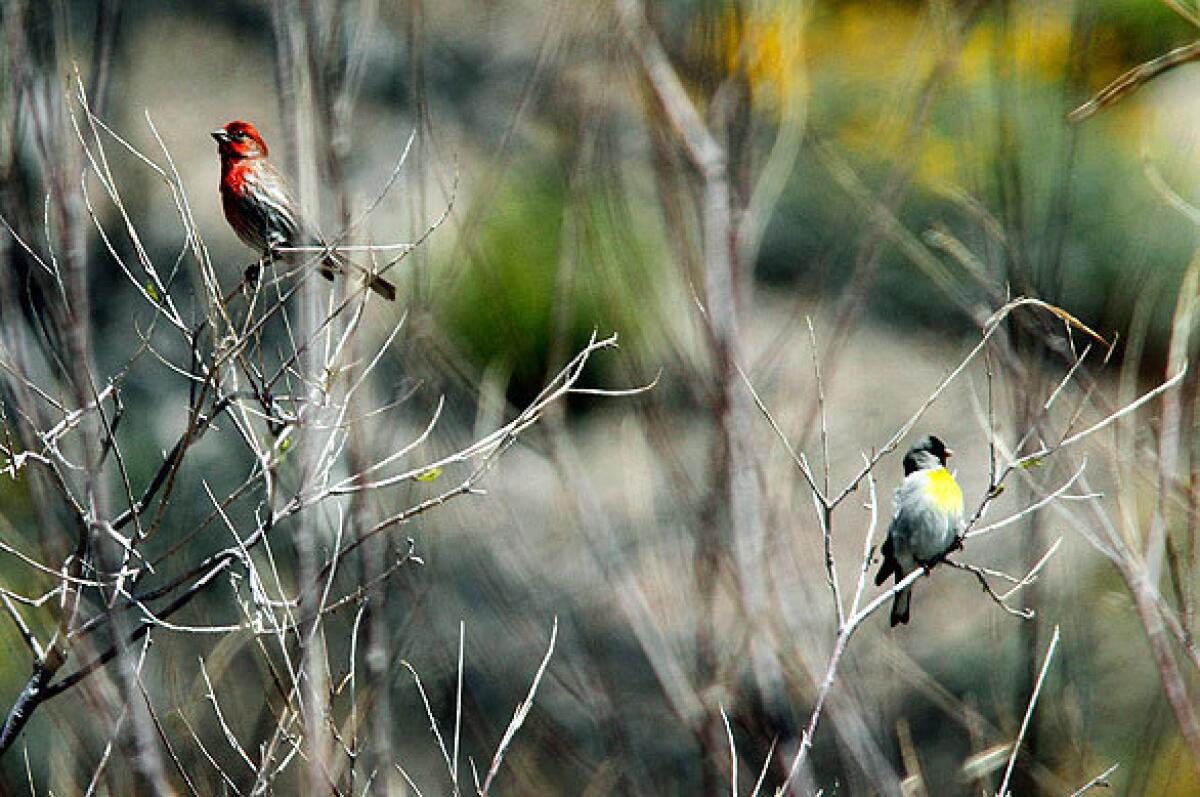Stuck at home? Now is the perfect time to learn the language of birds

- Share via
Being asked to stay away from your friends and neighbors is a bummer, but it’s also an opportunity to get to know the neighbors you might not know as well: the nonhuman variety.
You might be surprised just how much wildlife you can spot in a backyard, or under a park bench, or even right outside your window. It’s easy to tune out the animals and plans you see every day, but just because they’re familiar doesn’t mean they’re boring. Pay attention and you’ll discover they’re as fascinating as anything you might see on a safari or a scuba-diving expedition.
Right now it’s a particularly good time to get to know your local birds because they are singing like crazy. If you’ve been getting up before dawn thanks to daylight savings, you’ve probably noticed them. Are they singing for joy as the weather warms toward spring? Maaaybe ... but probably not. Most of those songs you’re hearing are fights over housing — who gets to live where.
The robins have returned to most of California with what sounds like a carefree looping tune (the rhythm is often described as: cheerily–cheer up–cheer up–cheerily–cheer up), but in fact they are singing so lustily to defend their property. “Don’t even think about it!” they might be saying, “I got here first and this branch is mine all mine!”
The song of a wrentit — a cute little brown flitter — fits better with the message. It sounds more like someone yelling at a dog about to poop in their yard, like, “Hey! Hey! Heyheyheyheyhey!”
If you want to know what the birds are saying, you have to only listen. Go somewhere green — a park, a backyard, or a still tree-filled street — and stay still. Wait long enough and tide of bird sounds will rise around you as your avian neighbors, who had gone quiet, decide you aren’t dangerous and start tweeting again.
Knowing that birds stop singing as potential predators approach is a little bit of a superpower: Pay attention and you’ll be able to hear the arrival of a person, or another animal, in the silence of the birds. And, if you listen long enough, you’ll start noticing different kinds of bird calls: Not just the territorial songs, but short chirps of alarm before the singing stops, and little call-and-response trills between companions. Birds are just always telling secrets about the world around you. All you need to decode them are your ears.
Many schools are closed because of the coronavirus pandemic. Check out The Times’ list of news, resources and more to help parents and children at home.
Try this: Find a spot with birds and listen quietly for at least 10 minutes. If you can’t immediately see where a bird call is coming from, trace it until you find the singer. Afterward, punch allaboutbirds.org into your internet browser and listen to the songs of these common (in California) and distinctive singers, to see if you can recognize a match.
Nathanael Johnson is a staff writer for Grist and the author of “Unseen City: The Majesty of Pigeons, the Discreet Charm of Snails and Other Wonders of the Urban Wilderness.”
More to Read
Sign up for The Wild
We’ll help you find the best places to hike, bike and run, as well as the perfect silent spots for meditation and yoga.
You may occasionally receive promotional content from the Los Angeles Times.

















